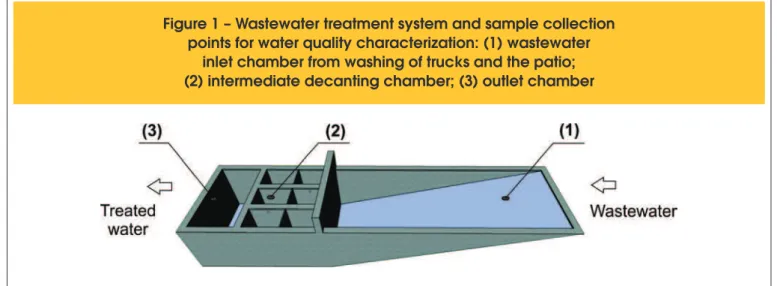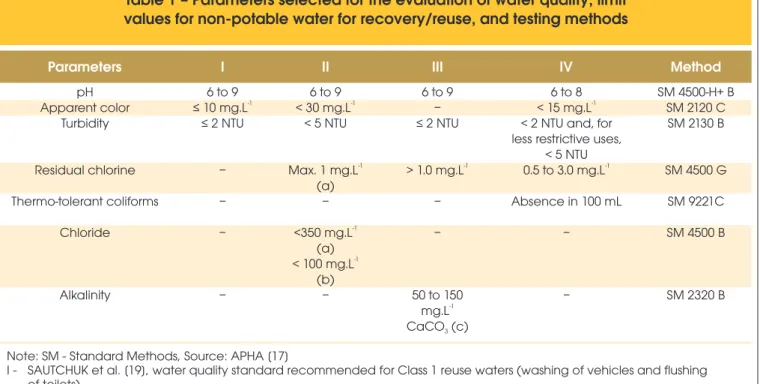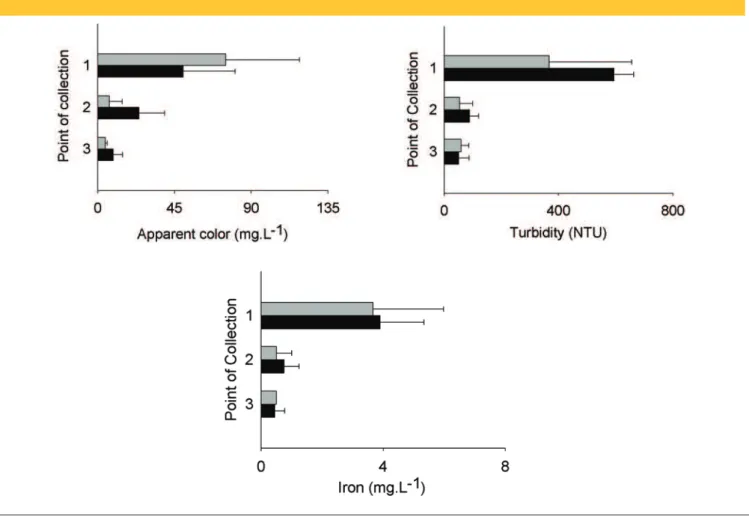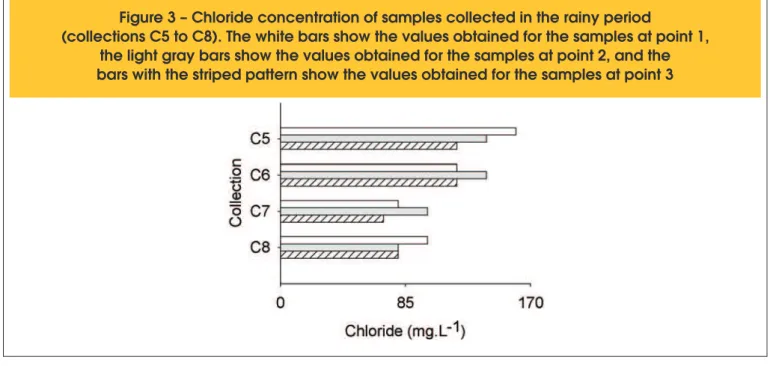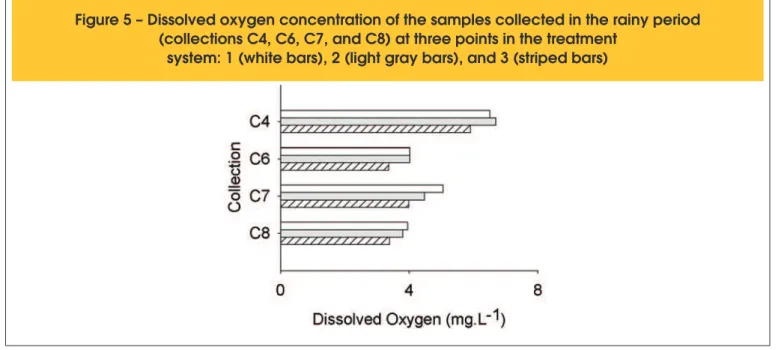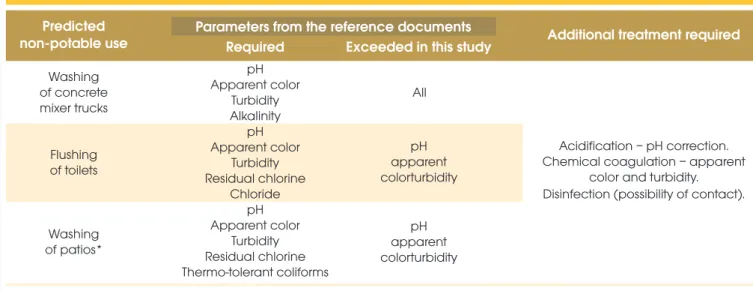Eficient water use is one of the most important requirements of cleaner production, and the use of the wastewater from concrete production can be an important means to this end. However, there are no Brazilian studies on the quality of concrete plant wastewater and the activities in which such water can be used. This paper aims to evaluate the quality of concrete plant wastewater and to propose guidelines for its treatment for non-potable applications. Wastewater samples were collected from three points in the studied treatment system, and tests were later performed in the laboratory to evaluate the water quality. The results obtained were compared with the limit values for the quality parameters that have been used for the analysis of the non-potable water supply in Brazil. The results indicate a need to at least add coagulation and pH correction processes to the treatment system.
Keywords: wastewater, concrete plants, water quality, treatment.
O uso eiciente da água se constitui em um dos principais quesitos a serem contemplados dentro do conceito de produção mais limpa e o uso da água residuária da produção do concreto pode ser uma importante medida para este im. Contudo, não se dispõe no Brasil de um estudo que indique a qualidade desta água e em quais atividades poderia ser reutilizada. O objetivo deste trabalho é avaliar a qualidade da água residuária de uma usina de concreto e propor diretrizes para o seu tratamento tendo em vista o reúso para ins não potáveis. Para tanto, foram coletadas amostras da água residuária em três pontos do sistema de tratamento existente na usina em estudo, sendo depois realizados ensaios em laboratório para a avaliação da sua qualidade. Os resultados obtidos forma comparados com os valores limite dos parâmetros de qualidade existentes nos principais documentos que vêm sendo empregados para a análise da água não potável para ins de abastecimento no pais. Os resultados obtidos indicam a necessidade de acrescentar ao sistema de tratamento existente, pelo menos, os processos de coa -gulação e a correção do pH.
Palavras-chave: água residuária, usinas de concreto, qualidade da água, tratamento.
Quality of concrete plant wastewater for reuse
Qualidade da água residuária de usina de concreto
para ins de aproveitamento
H. M. PAULA a heberdepaula@ufg.br M. S. O. ILHA b milha@fec.unicamp.br
Abstract
1. Introduction
Water usage is signiicant in concrete plants, not only in concrete production but also for washing waste in concrete mixer trucks, wa -shing patios, and sprinkling on aggregates to reduce dust (Sealey, Phillipse, and Hill [1]; Cement Concrete & Aggregates Australia [2]). The use of wastewater can reduce the consumption of pota -ble water and contribute to the cleaner production of concrete with regard to water usage.
Su, Miao, and Liu [3] emphasized that concrete wastewater shows high pH values, between 11 and 12, and high alkalinity due to the presence of hydroxides and carbonates in addition to the elevated concentration of solids. These characteristics make it necessary to treat wastewater prior to inal disposal, whether in water or soil. Concrete plants are subject to environmental licensing according to CONAMA Resolution No. 237 [4] because the production pro -cess involves the generation of environmental impacts. Lima et al. [5] surveyed the primary polluting activities of a concrete plant with a capacity of 40 m3.h-1, which includetransporting raw materials and concrete by trucks; the molding of specimens; washing the concrete mixer trucks; illing the trucks; and vehicle maintenance. Additionally, the authors performed a Risk Prevention Analysis, which classiies impacts by severity and frequency, and concluded that washing the trucks has the largest impact on the environment among the activities that take place within the plant, with an impor -tance of 10 on a scale with a maximum value of 20. The wastewa -ter from washing has a modiied pH that can cause the death of ish and contaminate groundwater.
The Brazilian national policy on solid wastes, instituted by Law No. 12305 [6], states that whenever liquids have properties that make it impossible to dispose of them in the public sewer system or in bodies of water or that require technically or economically unviable solutions with the best technology available, clean technologies must be adopted, developed, and improved to minimize environ -mental impacts.
CONAMA Resolution No. 448 [7] establishes in its irst paragraph that civil construction wastes cannot be disposed of in solid urban waste landills, in waste areas, on hillsides, in bodies of water, in empty lots, or in other areas protected by law. Thus, civil cons -truction irms must meet the requirements of CONAMA Resolu
-tion No. 430 [8], which establishes the condi-tions and standards for wastewater disposal in receiving bodies. The 2nd Article of this resolution establishes that wastewater disposal in soil, even after treatment, is not subject to the parameters and standards for dis -posal in the resolution; however, such wastewater must not cause the pollution or contamination of surface and subterranean waters. For the reuse of concrete wastewater, the type of treatment depen -ds on the activity for which the treated water will be used, normally the non-potable water supply.
NBR 15900 [9] establishes the parameters for concrete mixing water, taking into consideration the use of the concrete and which wastewa -ter can be reused, such as wa-ter from washing the concrete mixer trucks. According to this standard, seawater, brackish water, or water from sewage or treated sewage cannot be used for mixing concrete. Water from alternative sources must meet a series of chemical and physical requirements to be used in concrete production, not only so that the concrete’s properties are maintained, such as setting time and expected strength, but also so that the water used does not harm the concrete’s durability.
The studies found in the literature review indicate that concrete produced with wastewater from the factory shows compressive strength greater than 90% of that obtained for concrete produced with potable water, which is acceptable according to ASTM C94/ C94M [10] (Sandrolini and Franzoni [11]; Su, Miao, and Liu [3]; Chatveera, Lertwattanaruk, and Makul [12]) and EN 12390-2 [13] (Tsimas and Zervaki [14]), in addition to initial setting times with differences of less than 30 minutes, which is acceptable according to ASTM C403/C403M [15] (Su, Miao, and Liu [3]) and EN 196-3 [16] (Tsimas and Zervaki [14]).
Concrete mixing water must not contain impurities that impact the cement hydration reactions and the formation of its compounds. The use of wastewater in other activities that do not require potable water, such as washing concrete mixer trucks, was evaluated in only one study in the investigated literature; the study found that the concentration of solids must be monitored (Sealey, Phillips, and Hill [1]).
All of the evaluated studies, regardless of the destination of the wa -stewater, included a treatment system for improving the water qua -lity parameters (Sealey, Phillips, and Hill [1]; Tsimas and Zervaki [14]), which required, for its deinition, the characterization of the
Figure 1 – Wastewater treatment system and sample collection
points for water quality characterization: (1) wastewater
wastewater and the purpose for which the water would be treated. The objective of this article is to evaluate concrete plant wastewa -ter quality and propose guidelines for its treatment for use in acti -vities that do not require potable water in the concrete plant itself, such as washing the concrete mixer trucks, sanitizing the plant environment, lushing toilets, irrigating green areas, and washing patios. The article evaluates a single case study that may serve as a basis for the development of similar studies elsewhere.
2. Methodology
The study analyzed a concrete plant located in the southeastern region of the state of Goiás, Brazil, with an average monthly pro -duction of 2000 m³ of concrete.
An initial survey of several concrete plants indicated that the sys -tem typically used for wastewater treatment is composed of two or three sedimentation tanks. In the plant investigated in this study, the treatment system is composed of a wastewater inlet tank, six sedimentation chambers, and a wastewater outlet tank.
The water samples for the quality tests were collected at three dis -tinct points in the treatment system (Figure 1): (1) the inlet cham -ber, whose opening is found at loor level, (2) one of the sedimen -tation chambers, and (3) the outlet chamber.
The water inlet for the treatment system is found at loor level; thus, surface runoff, which contains debris from the patio, is also direc
-ted to this location. Therefore, collections were performed during two periods: one in the dry season and one in the rainy season. The samples for the determination of the apparent color, turbidity, and concentration of iron were collected at eight different times (C1 to C8), with three (C1 to C3) in the dry period (October and November 2012) and ive (C4 to C8) in the rainy period (December 2012 and January and February 2013).
In all cases, the samples were collected on the liquid surface using plastic bottles (PET). After collection, the samples were labeled and immediately transported to the laboratory for testing according to the APHA methods [17] shown in Table 1.
The tests evaluated the following characteristics of water quality: apparent color, turbidity, residual chlorine, thermo-tolerant colifor -ms, chloride, dissolved oxygen, alkalinity, hardness, and concen -trations of ammonia, iron, and chlorides.
Due to the availability of the reagents needed for the tests, the evaluation of residual chlorine and the test for the concentration of ammonia were only performed in the dry period (collections C1 to C3), and the tests for the concentrations of chloride and dissolved oxygen (DO) were conducted only in the rainy period (C4 to C8). Finally, the tests for hardness, alkalinity, pH, and thermo-tolerant coliforms were performed only on some of the collections and points in the treatment system.
The oxygen concentration readings were performed at three dis -tinct times: ive, ten, and ifteen minutes.
Table 1 – Parameters selected for the evaluation of water quality, limit
values for non-potable water for recovery/reuse, and testing methods
Parameters I II III IV Method
pH Apparent color Turbidity Residual chlorine Thermo-tolerant coliforms Chloride Alkalinity
6 to 9
-1
≤ 10 mg.L ≤ 2 NTU
– – –
–
6 to 9
-1
< 30 mg.L < 5 NTU
-1
Max. 1 mg.L (a) – -1 <350 mg.L (a) -1
< 100 mg.L (b)
–
6 to 9 – ≤ 2 NTU
-1
> 1.0 mg.L – –
50 to 150
-1
mg.L
6 to 8
-1
< 15 mg.L < 2 NTU and, for less restrictive uses,
< 5 NTU
-1
0.5 to 3.0 mg.L Absence in 100 mL
–
–
SM 4500-H+ B SM 2120 C SM 2130 B
SM 4500 G SM 9221C SM 4500 B
Because NBR 15527 [18] is the only standard in Brazil that consi -ders non-potable water quality, this standard was considered as a reference for the analysis of the quality parameters. This approa -ch is valid because the parameters refer to treated water; that is, they refer to the non-potable water supply, regardless of its ori -gin. Additionally, two other documents were considered that have also been used as a reference for the evaluation of the quality of the non-potable water supply in Brazil: Sautchuk et al. [19] and EPA/600/R-12/618 [20].
Thus, the results for pH, apparent color, turbidity, residual chlorine, thermo-tolerant coliforms, chlorides, and alkalinity were compared with the limit values for non-potable water found in Sautchuk et al. [19], EPA/600/R-12/618 [20], NBR 15527 [18], Manca and Jannu -zzi [21], and Lopes [22].
In turn, the results for the concentration of iron (Thiocyanate Me -thod, according to Boltz and Howell [23]) were compared with the limit values found in CONAMA Resolution No. 430 [8] for the clas -siication of water sources, using Class III waters as a reference (maximum iron concentration of 5.0 mg.L-1). The iron ion in the
water may be responsible for the appearance of stains on clothes, sanitary devices, and other surfaces (Moruzzi [24]).
To evaluate the water hardness, as determined according to the SM 2340 C Method (APHA [17]), water hardness is characterized by the presence of alkaline earth salts, such as calcium and mag -nesium. These elements confer a disagreeable lavor and a laxa -tive effect, reduce the formation of soap suds, thereby increasing soap consumption and causing scaling on pipes and boilers (Roloff [25]). The values found in Von Sperling [26] were considered as a reference to evaluate the hardness of the water. According to the -se standards, soft water has less than 50 mg.L-1 CaCO
3, modera -tely hard water has between 50 and 150 mg.L-1 CaCO
3, hard water has between 150 and 300 mg.L-1 CaCO
3, and very hard water has more than 300 mg.L-1 CaCO
3.
For dissolved oxygen (DO), which was determined according to the SM 4500-O Method (APHA [17]), the value recommended by Fiorucci and Benedetti Filho [27] (2.5 mg.L–1) was used to avoid problems of corrosion in pipes and accessories.
Finally, a comparative analysis was performed for the results obtai
-Figure 2 – Average values for apparent color, turbidity, and iron concentration for samples collected
at three points in the treatment system: 1 (inlet chamber), 2 (intermediate chamber),
and 3 (outlet chamber). The gray bars represent the values obtained for samples collected in
the rainy period, and the black bars represent the values obtained for samples
ned for the apparent color, turbidity, and iron concentration using the non-parametric Wilcoxon test for paired results, with a signii -cance level of 0.05. This test was selected due to the small amount of data, the dependence of the results obtained on the three points of the treatment system, and the lack of evidence of normality of the data (Bunchaft and Kellner [28]; Volpato and Barreto [29]). For this analysis, the data from the two collection periods (dry and rainy) were considered together.
3. Results and discussion
Figure 2 shows the results for apparent color, turbidity, and iron concentration for the samples collected at the three points of the treatment system in the rainy and dry periods.
The apparent color of the samples collected in the rainy period was higher at point 1, indicating the determinant contribution of the surface runoff from the concrete plant patio in this parameter. As the water passed through the treatment system, there was a signiicant reduction in the apparent color for both the rainy and dry periods. The average value of the apparent color in the rainy period was 75 mg.L-1 at point 1, 6.7 mg.L-1 at point 2, and 4.3 mg.L-1 at point 3. In the dry period, these values were 50 mg.L-1 for point 1, 24 mg.L-1 for point 2, and 9.0 mg.L-1 for point 3. The application of the statistical test to the complete data set (rainy and dry periods together) conirmed the effectiveness of the system used to reduce this parameter because the values obtained for the samples from point 1 were signiicantly different from those obtained for points 2 and 3 (p < 0.05); in addition, the values obtained for point 2 were signiicantly different from those obtained for point 3.
The turbidity and concentration of iron showed a similar behavior to the apparent color, with signiicantly higher values at point 1 and a sig -niicant decrease as the water passed through the treatment system. The water collected at point 1 showed large quantities of suspen -ded solids, with turbidity values between 200 NTU and 700 NTU. Although the average values were higher in the dry period, the va
-lues in the rainy period were similar at this point, indicating that the determining factor for turbidity was the difference in the quantities of debris in the wash water from each concrete mixer truck. The results for turbidity at point 1 were signiicantly higher than those obtained for point 2 and point 3 (p = 0.0017 in both cases). In contrast, the results obtained for point 3 were not signiicantly different from those found for point 2, indicating that there was little improvement in this parameter between these two points.
The concentration of iron at each of the analyzed points was sli -ghtly higher in the dry period due to the lower volume of surface runoff water in the treatment system during the dry period. The presence of this metal was primarily due to concrete ballast that returns to the plant, which sediments as it passes through the tre -atment system.
Similar to turbidity, the results obtained for point 1 were signiican -tly higher than those obtained for point 2 and point 3 (p = 0.017 in both cases). The results obtained for point 3, however, were not signiicantly different from those obtained for point 2 (p = 0.208), indicating that there was little improvement in this parameter be -tween these points.
The similarity between the results obtained for points 2 and 3 for turbidity and the concentration of iron were due to the relatively high velocity of water low in the treatment system, which made particle sedimentation dificult.
To analyze the viability of reusing treated water for non-potable purposes, the values of the parameters investigated at point 3 were considered, from the outlet chamber of the treatment system. For apparent color, the limits speciied in the reference document for non-potable water quality were met, with the exception of two collections performed on subsequent days in the rainy period, in which the results were only higher than the limit recommended by Sautchuk et al. [19] for class I reuse waters, which are for washing vehicles and lushing toilets. Thus, if these were the inal uses of the treated water, an additional treatment process would be neces -sary to remove the color.
Figure 3 – Chloride concentration of samples collected in the rainy period
For turbidity, the values found at point 3 were always higher than the limits recommended for non-potable water in the reference do -cuments used, which also indicates a need for treatment in addi -tion to that existing at the plant.
As previously noted, limit values for the concentration of iron in non-potable water were not found in the consulted reference docu -ments. Therefore, the limit value for potable water found in CONA -MA 430 [8] was considered; all of the values obtained were within the limits established by the referenced resolution.
Figure 3 shows the results for the concentration of chloride in sam -ples from four collections performed in the rainy period from the three points studied. In the dry period, this test was performed on
only the samples from some of the collections due to the availabili -ty of the reagents, resulting in an average of 40 mg.L-1 at the three collection points. There was a small amount of variability between the data in this period; however, it was not signiicant. In the rainy period, the values were higher (average value of 120 mg.L-1 for the three collection points).
The behavior of this parameter was not the same in all of the col -lections; in some of the collections, the highest values occurred in the intermediate chamber (point 2), and in others, the highest values occurred in the inlet (point 1). According to Su, Miao, and Liu [3], the quantity of chloride increases with tank depth due to the sedimentation of solids. Because sample collection was performed
Figure
4 – Residual chlorine concentration of samples collected in the dry period (collections C1
to C3). The white bars show the values obtained for the samples collected at point 1 (inlet chamber),
the light gray bars show the values for the samples collected at point 2 (intermediate chamber), and
the bars with the striped pattern show the values for the samples collected at point 3 (outlet chamber)
Figure 5 – Dissolved oxygen concentration of the samples collected in the rainy period
(collections C4, C6, C7, and C8) at three points in the treatment
near the surface of the water, sedimentation of suspended mate -rial occurred from one point to another, decreasing the quantity of chloride dissolved in the water.
Only Sautchuk et al. [19] presented a limiting value for this para -meter for the non-potable water supply, and all of the values found in the collected samples were less than this value. Therefore, an additional treatment process would not be necessary to reuse the treated water.
The residual chlorine concentration from one sample collected in the rainy period was 0.25 mg.L-1 for points 1 and 2, and 0.50 mg.L-1 for point 3. The values for this parameter for the dry period (collections C1 to C3) are shown in Figure 4. The residual chlori -ne concentration was not homoge-neous in the different samples collected; this parameter was signiicantly higher at point 1 in one sample and at point 3 in another. With the exception of the last collection, the values obtained for points 2 and 3 were equal. The results obtained were lower than the values found in NBR 15527 [18], which suggest an interval from 0.5 to 3.0 mg.L-1.
The dissolved oxygen (DO) concentrations for the samples collec -ted in the rainy period are shown in Figure 5. There was a slight decrease in this parameter from point 1 to point 3 in the majority of the collections. The limit proposed by Fiorucci and Benedetti Filho [27], however, was exceeded in all of the samples, regardless of the point of collection.
Thus, to reuse the water, it would be necessary to correct the dis -solved oxygen concentration because elevated values of this para -meter can cause corrosion of pipes and accessories, among other problems. The average temperature of the concrete wastewater was maintained between 24.7 and 27.8°C. A higher temperature would cause a decrease in the solubility of oxygen in the water. The alkalinity values of the wastewater were elevated due to the presence of concrete ballast residues in the concrete mixer tru -cks. The alkalinity values were obtained from all three points: one in each collection performed in the month of October 2012 (C1 –
point 1 and point 3; C2 – point 2) and one for the last collection in the month of February 2013 (C8), presented values respectively, of 1200 and 760 mg.L-1 (point 1), 1680 and 660 mg.L-1 (point 2), and 1550 and 680 mg.L-1 (point 3), respectively, exceed the limits for water reuse indicated by the EPA/600/R-12/618 [20]. The pH was determined for the samples collected at the three investigated points in the dry period and in the irst collection (C4) from the rainy period; the results showed an average value of 12.5. Cement is rich in carbonates and bicarbonates, and these were the primary causes of the elevated alkalinity values and the elevated pH. Thus, the pH must be decreased to reuse the treated water.
The tests for total hardness (determined for samples from collec -tions C1 and C2 from the dry period and for points 1 and 3 only) resulted in values greater than 1400 mg.L-1 CaCO
3, indicating that the water was very hard (>300 mg.L-1 CaCO
3). This result was hi -gher than the result for alkalinity, which showed a lower concentra -tion of soluble bicarbonates. Waters with elevated hardness and alkalinity cause a continuous and harmful internal inorganic scaling formation process in pipes, initially from the supersaturation of sli -ghtly soluble or insoluble salts, resulting from the evaporation of water. Thus, an additional treatment process is needed to reuse the wastewater.
Thermo-tolerant coliforms were not found in any of the samples collected from the three investigated points, which indicates that there was no type of microbiological contamination in the water collected from the treatment system.
Table 2 shows a summary of the results obtained, with indications of the water quality parameters and the type of treatment to be con -ferred on the non-potable water for reuse in the different activities identiied in the plant that do not require potable water. Although no coliforms were detected in the wastewater, disinfection is recom -mended as a preventative measure because there is a possibility of skin contact with the treated water. Additionally, the hardness and dissolved oxygen in the water need to be corrected. These
Table 2 – Summary of the results obtained for concrete plant wastewater
quality and identification of additional treatment requirements for non-potable reuse
Predicted
non-potable use Parameters from the reference documentsRequired Exceeded in this study Additional treatment required
Washing of concrete mixer trucks
pH Apparent color
Turbidity Alkalinity
pH
parameters were not considered in the consulted documents but are important for the wastewater in question.
4. Conclusions
The concrete wastewater quality indicates a need for additional treatment for non-potable reuse in the plant. Considering the re -ference documents that have been used in Brazil for non-potable water quality reuse, the pH, apparent color, and turbidity need to be corrected. For the probable inal non-potable uses, there is also a need to correct the alkalinity and the hardness.
Thus, for non-potable use in the plant, coagulation and pH cor -rection would at least need to be added to the treatment process. The use of chemical coagulants, such as aluminum sulfate and ferric chloride, however, increases the volume of sludge generated during treatment, in addition to altering some physical and chemi -cal parameters of the water. There are also problems associated with aluminum waste that can cause Alzheimer’s at concentrations greater than 200 μg.L-1 (Bhatti, Mahmood, and Raja [30]). For this reason, it is important to investigate the possibility of using natural coagulants with a lower environmental impact.
Additionally, preventative disinfection is recommended due to the possibility of users’ direct contact with the treated water.
The water’s passage through the existing treatment system in the plant, which is essentially composed of sedimentation chambers, provided an improvement in the wastewater quality, with the excep -tion of turbidity and the concentra-tion of iron, in which there was no signiicant difference between the samples collected at point 2 (the intermediate chamber) and those collected at point 3 (the outlet chamber). This result may be caused by the relatively high water low velocity, which makes particle sedimentation dificult.
5. References
[01] SEALEY, B.J; PHILLIPS, P.S; HILL, G.J. Waste management issues for the UK ready-mixed concrete industry. Resources, Conservation and Recycling, v. 32, p. 321-331, 2001. [02] CEMENT CONCRETE & AGGREGATES AUSTRALIA. Use
of Recycled Water in Concrete Production. Australia, 2007; 27p.
[03] SU; MIAO, B; LIU, F. Effect of wash water and underground water on properties of concrete. Cement and Concrete Re -search, v. 32, p. 777-782, 2002.
[04] BRASIL. Ministério do Meio Ambiente. Resolução CONAMA Nº 237, DE 22 DE DEZEMBRO DE 1997. Regulamenta os aspectos de licenciamento ambiental estabelecidos na Po -lítica Nacional do Meio Ambiente [Ministry of the Environ -ment. CONAMA Resolution No. 237, DECEMBER 22, 1997. Regulates the aspects of environmental licensing establi -shed in the National Environmental Policy]. Publi-shed in the DOU No. 247, Monday, 22 December 1997. Diário Oicial da União, Brasília, 22 December 1997.
[05] LIMA, A. P.; MOREIRA, B.; ARAÚJO, L. E.; GABRIELE, P. D.; CARVALHO, M. Sustentabilidade na Construção Civil [Sustainability in Civil Construction]. In: Congresso Nacional de Excelência em Gestão, 5°, 2009, Niterói. Anais, Niterói, 2009, 16p.
[06] BRASIL. Ministério do Meio Ambiente. Lei Nº 12.305: Institui a Política Nacional de Resíduos Sólidos; altera a Lei no 9.605,
de 12 de fevereiro de 1998; e dá outras providências [Ministry of the Environment. Law No. 12,305: Institutes the National Policy for Solid Wastes, alters Law No. 9,605, February 12, 1998, and provides other measures]. Brasília, 2010.
[07] BRASIL. Ministério do Meio Ambiente. Resolução CONAMA Nº 448, DE 18 DE JANEIRO DE 2012 Publicada no DOU Nº 14, quinta-feira, 19 de janeiro de 2012. Altera os arts. 2º, 4º, 5º, 6º, 8º, 9º, 10º e 11º da Resolução nº 307, de 5 de julho de 2002, do Conselho Nacional do Meio Ambiente [Ministry of the Environment. CONAMA Resolution No. 448, JANUARY 18, 2012 Published in the DOU No. 14, Thursday, January 19, 2012. Alters Art. 2, 4, 5, 6, 8, 9, 10, and 11 of Resolution No. 307, July 5, 2002, from the National Council on the Envi -ronment]. Diário Oicial da União, Brasília, 19 January 2012. [08] BRASIL. Ministério do Meio Ambiente. Resolução CONAMA Nº 430, DE 13 DE MAIO DE 2011, Dispõe sobre as condi -ções e padrões de lançamento de eluentes, Complementa e altera a Resolução no 357, de 17 de março de 2005, do Conselho Nacional do Meio Ambiente-CONAMA [Ministry of the Environment. CONAMA Resolution No. 430, MAY 13, 2011, Adopts provisions and standards for the disposal of wastewater, complements and alters Resolution No. 357, March 17, 2005, of the National Council for the Environ -ment]. Diário Oicial da União, Brasília, 16 de Maio. 2011. [09] ASSOCIAÇÃO BRASILEIRA DE NORMAS TÉCNICAS.
Água para amassamento do concreto Parte 1: Requisitos – NBR 15900 [Water for mixing concrete Part 1: Requirements – NBR 15900], Rio de Janeiro, 2009.
[10] AMERICAN SOCIETY FOR TESTING AND MATERIALS. ASTM C94 / C94 M – 99: Standard Speciication for Ready --Mixed Concrete. Philadelphia: American Society for Testing and Materials, 1999.
[11] SANDROLINI, F; FRANZONI, E. Waste wash water recycling in ready-mixed concrete plants. Cement and Concrete Re -search, v. 31, p. 485-489, 2001.
[12] CHATVEERA, B; LERTWATTANARUK, P e MAKUL, N. Effect of Sludge Water from Ready-mixed Concrete Plant on Properties and Durability of Concrete Cement and Concrete Composites. Elsevier, v. 28, n. 5, p. 441-450, 2006.
[13] EUROPEAN COMMITTEE FOR STANDARDIZATION (CEN). EN 12390-2: Testing hardened concrete – Part 2: Making and curing specimens for strength tests. Brussels. 2008.
[14] TSIMAS, S; ZERVAKI, M. Reuse of waste water from ready --mixed concrete plants. Management of Environmental Qua -lity: An International Journal, v. 22, n. 1, p. 7–17, 2011. [15] AMERICAN SOCIETY FOR TESTING AND MATERIALS.
ASTM C403/C403 M-99: Standard Test Method for Time of Setting of Concrete Mixtures by Penetration Resistance. Philadelphia: American Society for Testing and Materials, 1999.
[16] EUROPEAN COMMITTEE FOR STANDARDIZATION (CEN). EN 196-3: Methods of testing cement – Part 3: De -termination of setting times and soundness. Brussels, 2008. [17] AMERICAN PUBLIC HEALTH ASSOCIATION. Standard
methods for the examination of water and wastewater. 22 ed., 2012. 1496p.
-va - Aproveitamento de coberturas em áreas urbanas para ins não potáveis – Requisitos. - NBR 15527 [Rain water – Recovery from roofs in urban areas for non-potable uses – Requirements – NBR 15527], Rio de janeiro, 2007.
[19] SAUTCHUK, C.; FARINA, H.; HESPANHOL, I.; OLIVEIRA, L. H.; COSTI, L. O.; ILHA, M.S.O.; GONÇALVES, O.M.; MAY, S.; BONI, S.S.N.; SCHMIDT, W. (2005) – Conservação e reúso da água em ediicações – Manual da FIESP [Con -servation and reuse of water in buildings – Manual of the FIESP]. São Paulo. 151 p.
[20] U.S. ENVIRONMENTAL PROTECTION AGENCY (USEPA). 2012. Guidelines for Water Reuse. EPA. EPA/600/R-12/618, September 2012. Environmental Protection Agency. Wa -shington, D.C.
[21] MANCA, R. S.; JANNUZZI, G. M. O planejamento integra -do de recursos -do setor energético como base para o ge -renciamento dos recursos hídricos em áreas urbanas [The integrated planning of resources from the energy sector as a basis for the management of water resources in urban are -as]. Engenharia Ambiental – Espírito Santo do Pinhal, v. 5, n. 3, 2008, p. 323 – 341.
[22] LOPES, G. B. Estudo de viabilidade técnica do aproveita -mento de água de chuva para ins não potáveis na Universi -dade Federal de Uberlândia [Study of the technical viability of rain water recovery for non-potable uses in the Federal University of Uberlândia], Uberlândia (MG), Uberlândia, 2012, Masters Dissertation– Federal University of Uberlân -dia, 190 p.
[23] BOLTZ; HOWELL. Colorimetric Determination of Nonmetals. 2nd ed., vol. 8. John Wiley & Sons Inc, 1978. 564 p. [24] MORUZZI, R. B. Oxidação e Remoção de Ferro e Manga
-nês em Águas para ins de Abastecimento Público ou In -dustrial – uma abordagem geral [Oxidation and Removal of Iron and Manganese in Waters for Public or Industrial Supply Purposes]. Revista de Engenharia e Tecnologia, V. 4, n. 1, p. 29-43, 2012.
[25] ROLOFF, T. A. Efeitos da não Aplicação do Controle de Qua -lidade da Água nas Indústrias Alimentícias [Effects of Not Applying Water Quality Control in the Food Industry]. Sa -Bios: Rev. Saúde e Biol., v. 1, n.1 p.52-57, 2006.
[26] VON SPERLING, M. Introdução à qualidade das águas e ao tratamento de esgoto [Introduction to water quality and sewage treatment]. 3nd ed. – Belo Horizonte: Department of Sanitary and Environmental Engineering; Federal University of Minas Gerais; 2006.
